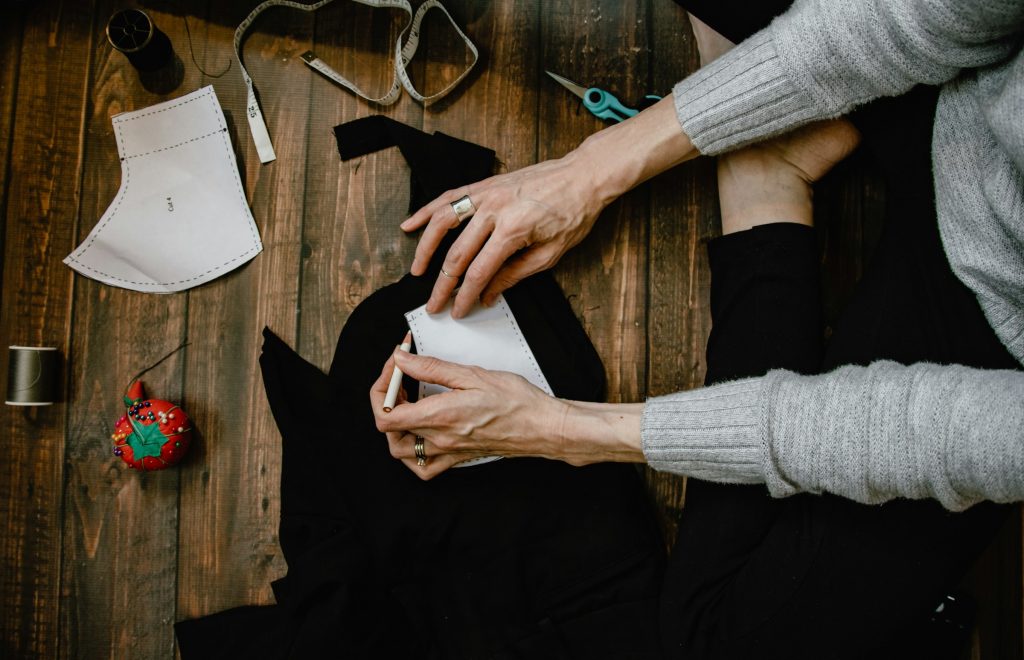The idea of making our own dresses by hand is exciting and romantic for any budding sewer. After practicing stitches and methods on more basic sewing projects, it’s fun to work on a larger, beautiful garment you can wear. Even better, learning to make dresses from patterns gives us the chance to create bespoke pieces for friends and family. We all have to start somewhere. So, here are some tips about using the best dress sewing patterns for the first time.

10 Tips For Your First Dress From A Sewing Pattern
10 Things To Remember When Sewing Your Very First Dress
1) Set yourself up with a good sewing machine
Before you can get caught up in choosing fabrics and patterns, you need the right tools for the job. Not all sewing machines are created equally. Some are much tougher and faster than others, letting sewers handle all kinds of fabrics and tasks with ease. Some will come with a wider range of feet and accessories to handle different types of stitches, seams, and other elements. The more you have and the better the manual, the greater your chance of success the first time.
2) Find an easy dress pattern
A common mistake here is for first-time sewers to pick something that says “easy” on the packet but is actually deceptive in its form. You want something that doesn’t require an excessive amount of cutting and sewing to reduce the risk of mistakes. You also want to choose something that doesn’t require much precise fitting to look good. Some designs can cause a domino effect of issues if you mess up one seam, dart placement, or other detail. This means no buttons and no precise bodice work as you get started.
3) Find something online
Look online for something that looks appealing and meets the criteria above. Some great websites offer the best dress sewing patterns for women with user-friendly images, descriptions, and purchasing options. Try and find something that will give you a beginner-friendly printed pattern and clear printed instructions to work with. This is a much better reference than working from a screen.
4) Choose the right fabric type
You may already have something in mind for this first dress. Maybe you like the idea of working in light cotton for a simple summer dress or satin for a more elegant evening gown. The problem with the latter is that shiny, slippery fabrics are difficult to work with and can lead to problems with the fit. It is best to choose woven fabrics that won’t stretch for your first projects. The material will not be distorted when cutting and sewing the pieces and will look great.
5) Choose the right color and pattern
In addition to fabric type, you need to think about the pattern and aesthetic of the material. Obviously, you want something that suits your style and personality. However, you also want to consider choosing a plain fabric rather than anything patterned. Floral dresses are great for summer, and stripes can add drama. Still, it’s best not to think about pattern matching on a first piece and save that puzzle for another time.
6) Get your measurements
You can’t cut your pattern pieces to the right size without a good idea of your measurements. It is better to get the tape measure out and be sure than to estimate. Some first-timers make the mistake of cutting pieces in line with the dress size they get in the store. However, these don’t always match up, and you could end up with something way too small. Get the measurements and match them to the closest available size. You can always make adjustments if it’s a touch too big later.
7) Read the instructions carefully
Remember when exam papers warned us to read the questions carefully before attempting to answer them? Well, it’s a similar situation when dealing with these dress sewing patterns. The best ones will come with a lot of instructions and maybe some diagrams to show you the step-by-step process. The more detailed the list, the easier it should be to work through it. It’s also too easy to skip something if you’re too eager. So, read through it all and visualize the process before you start. Google any terms and techniques you don’t recognize and use YouTube tutorials where necessary.
8) Make a mock-up
This is highly recommendable if you have the time and are keen to get this dress right the first time. Mock-ups let you run through the methods and steps on a practice run without the pressure of being mistake-free. Many sewers make this mock-up, or toile, to give it its correct name, with calico or some other cheap fabric. This hands-on and visual approach can make it easier to understand how the dress goes together and will show any mistakes. You can learn from the experience and then move on to the real thing.
9) Take your time on the real thing
Even with this time spent on the mock-up dress, it helps to be careful and steady with every step of the real dress. Take your time drawing out the pattern pieces, cutting them to the right size, pinning them all together, and creating neat stitches. It is better to take twice as long as planned if it means a flawless, beautiful dress that fits the first time.
10) Remember that practice makes perfect
This final point is just as important as any other. There is a good chance that even with the mock-up and careful reading, something will be a little off. A hem might be crooked, or a strap a little too wide. That’s fine. Be proud of what you have made, show it off to people, and start planning your next project. Eventually, you’ll have a series of these top dress sewing patterns in your collection and be able to make all kinds of pieces for family and friends.
Hopefully, these 10 tips will help you get set up for your first attempt at making a dress. Once you’ve mastered this first dress sewing pattern and gained confidence with the steps, you can start getting more creative. Adapt the pattern to suit your style, bring in those patterned fabrics, and try more advanced designs. You’ll soon find yourself hooked and inundated with requests from friends and family.









